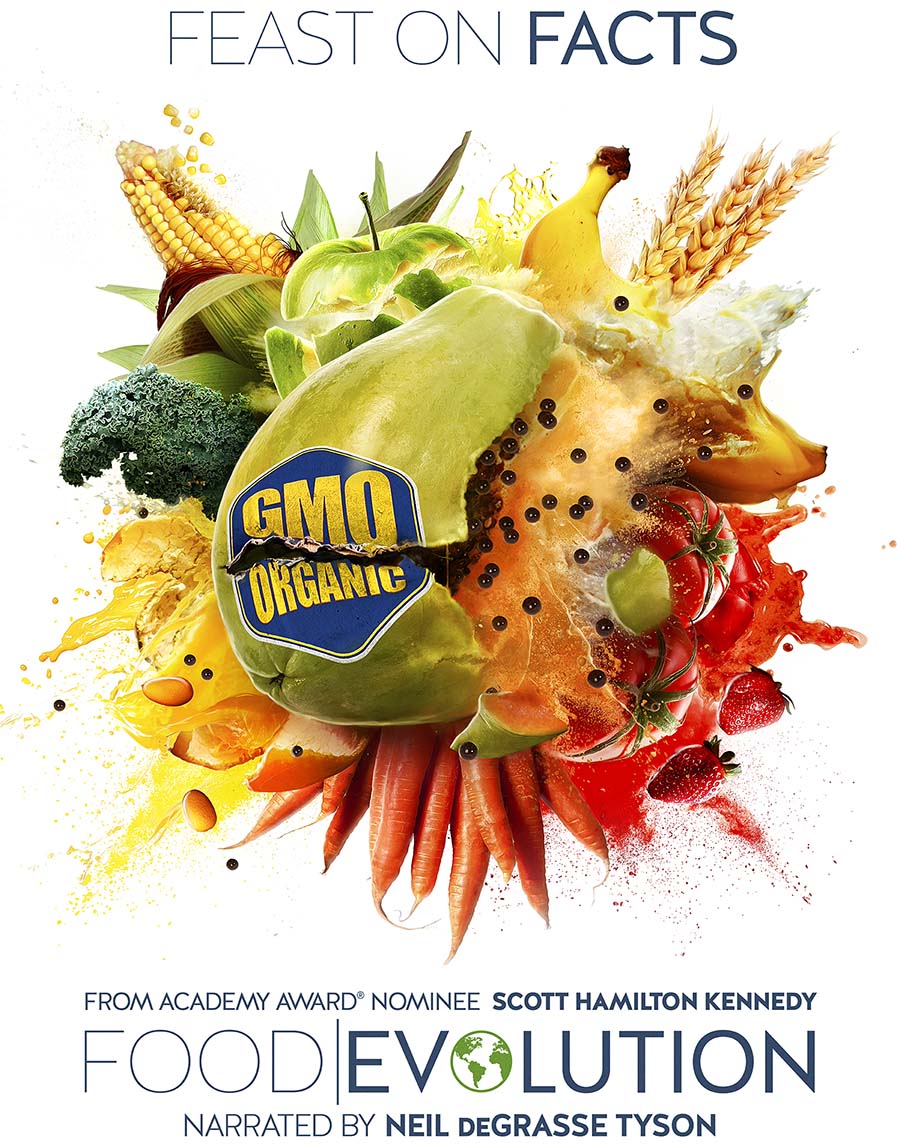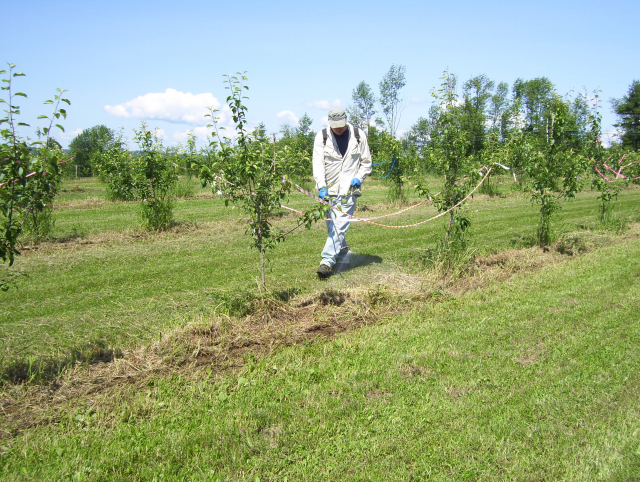There’s a new documentary film out now, “Food Evolution”, that is reported to be a potential game-changer on the public perception and acceptance of genetically engineered (GE, or oversimplified as GMOs) crops. I haven’t seen the film- it was just released and doesn’t have a screening near me, and a one-night only one at a non-traditional theatre venue at that, until next Thursday. It has been shown at quite a few pre-screening events, so I’ll allow some license and assume that the 45 university faculty and other academics who recently signed a letter calling the film “propaganda” (whom I’ll call, “The 45”, for lack of a better term) have all seen it, although I believe that would have been difficult given their geographic distribution across and around the country. So this is not a critique of the film, it’s a critique of the knee-jerk criticism around it and a plea for a more informed conversation.
Let me start by saying that I think documentaries are a terrible way to convey objective information on just about any topic. Every piece of media has a bias, from dry research papers to lectures to films and videos. But documentaries, via their mixed visual, audio, storytelling, editing, and one-way dialog methods are particularly egregious. There is a whole genre of “Food and Farm Films” that has emerged in the current millennium, and many of the most popular ones, e.g., Food, Inc., The Future of Food, GMO OMG, Genetic Roulette, etc., are indeed extremely one-sided and in some cases blatant propaganda against modern agricultural systems, especially the use of biotechnology in agriculture. Much of the debate around GM crop technology is indeed fueled by well-financed, private companies and activist groups that have funded biased research and promoted media that stretch the lines of clear and logical reporting. Food Evolution is the first, or at least to my knowledge the most high-profile, documentary that reports from the pro-science side of the debate, which is so often misrepresented in the public media around GE crops.
As I said, I haven’t seen the film, but I have been following the discussion around it since it was being made. I also read both the literature and the popular and semi-scientific press around GM and other modern agriculture practices, and their application to food system sustainability. As an academic myself, I feel it is critically important to discuss an argument on its own merits, and to only discredit an argument based on characteristics of its presenter when that person has continually and egregiously shown a disregard of facts, science, logic, and respect.
So, in the response to the film that started this post, I see numerous ad-hominem attacks, as well as several statements that simply state that the film does not agree with the authors’ beliefs and therefore should be rejected as propaganda. First is the statement that the film “manufactures scientific consensus [on the safety of GE crops] where no such agreement exists”, and cites an editorial letter signed by fifteen anti-GM scientists and activists. I’m no expert on what makes a consensus, but the definition I use is the facts and conclusions around a particular issue on which those who have fully investigated the subject reach agreement and move on to the next matter for discussion. Of course there is always more research to be done on matters, but the overwhelming majority of scientific societies and regulatory bodies and scientists with understanding of the biological nature of GM crops have agreed that the use of biotechnology in agriculture is safe. That does not mean debate ends there- there is always need for discussion on the best uses of the technology, its deployment in specific crop/pest/production systems, effects on supply chains and economics, and certainly on the regulatory process surrounding them. But to say that there is a legitimate question of the safety of the technology as a whole is untrue.
The authors of the critique then accuse the filmmakers of editorial bias in how they included GMO opponents in the film. Again I have not seen it, but there are a few points to make here. First, the fact that the filmmakers included substantial input and screen time from GM opponents suggests that they were open to dialog. Second, of course the sound bites were edited; that’s what a filmmaker needs to do to fit their narrative into a ninety-minute story line. Now a few of those included in the film are crying foul because their truthful statements are being used in a film supporting modern agriculture, which goes against their narrative and that of the movement in which they align. Dr. Marion Nestle is one of the most critical, and has openly critiqued her portrayal in the film (and Michael Pollan has followed up with a less well-developed, “yeah, me too” statement). However, I have not seen anyone point out where the statements used were edited as to be untruthful. I would be interested in seeing a director’s cut with the rest of the interviews, but let’s face it- this film was designed (biased, as we all are) to tell its story. If they wanted Dr. Nestle to answer the question of whether or not GM crops are inherently safe to consume, then it’s their right to show that, as long as they didn’t splice the piece together to make it up. Dr. Nestle has her own substantial platform to provide the “yes, but…” qualifications to her statement.
As for inviting all sides of the debate to the table, a recent, comprehensive review of GM crop safety, applications, problems, and promises that did just that was undertaken by the National Academies of Sciences, Engineering, and Medicine (NASEM). The study was as comprehensive as any that has been conducted before or since, and included substantial input from published studies, public comments (over 700 reviewed), statements in public meetings and webinars, and two rounds of blind peer-review which included signers of the letter that started this post. The resulting, 606 page report is quite comprehensive, and, overall, paints GM crops in a positive light but also offers nuanced analysis of the safety, environmental, and economic impacts of the technology as it is presently and may potentially be used. Naturally, after the report was released, critics cried foul that the authors and reviewers were tied to corporate interests, and NASEM has pretty clearly refuted those accusation of bias. Look, when assembling a panel of professionals with diverse and extensive experience on a certain issue, many will have worked in one way or another in that field- that’s what makes them experts. That does not immediately assume nefarious wrongdoing on their part when critically examining a topic they know well.
Early in the process, a group of academics, many of whom are among The 45, denounced the makeup of the NASEM panel as essentially too reductive in their expertise, and not sufficiently rounded out by social scientists, agroecologists, farmers, women, or international experts. However, biotechnology supporters derided the report as not positive enough toward green-lighting GM crops. If both extremes on an issue highlight similar but opposing (and thus balancing) viewpoints on a subject, I’m inclined to believe that the presentation is balanced. The point in discussing that report here, is that a comprehensive, public, balanced forum has been provided and results written that did indeed include diverse viewpoints, and still reaches the conclusion as this film does that GM crops are safe and may be a useful tool to improve the sustainability and safety of food production.
Continuing with the original letter, more ad-hominem attacks are presented. The project funder, Institute for Food Technologists, is “an advocacy organization which has long endorsed the biotech industry,” despite it’s 70-year history as an academic and industry organization in support of scientific advancement in food production. “Mark Lynas works with the Cornell Alliance for Science, formed in 2014 with a US$5.6 million grant from the Bill & Melinda Gates Foundation to “depolarize” the debate over GM foods” (So what? Are they spreading untruths?). Animal scientist Dr. Alison Van Eenennaam “has worked in the past for Monsanto (so what if she did, if her science is accurate and truthful?). The notion that a person must be entirely discredited, despite being a leader in their field, because of past employment or funding from a company that you dislike or distrust, is not a logical refutation of their work.
Full disclosure: I once received match funding for a research trial on organic soil disease management from a company that was later bought by a division of Monsanto. I describe that here. If that makes me a biased pawn of agribusiness, so be it. More disclosure: my academic CV is publicly available here . It contains the word ‘organic’ over ninety times, I received both graduate degrees working in organic production systems, and I founded and direct an organic teaching farm. Does that make me a pawn of ‘Big Organic’? I’d say that both disclosures are common of the types of scientists who hold a balanced, farm and food-centered perspective on agriculture. And a review of scientific articles on GM crops comparing funding sources and conclusions also indicated that there was little concern of false science in the peer-reviewed literature based on study funding, but that professional conflicts of interest (e.g. a scientist working for a corporation) were correlated with results favorable to the corporation (Diels et al. 2011).
So, public, University scientists tend to publish diverse articles regardless of funding source, including corporate funding (likely because we get ‘graded’ partly on the number of papers we publish); while corporate scientists publish information that helps the corporation, which is, by definition, a profit-driven institution. That doesn’t surprise me one bit, nor does it a) discount the independence of good public scientists nor b) discredit well-designed science that is published with a profit motive. Then again, poor science that muddies the discussion and is backed by corporate funds is indefensible, including some science that is expressly and overtly funded by organic food companies to cast doubt on the safety of non-organic food, thus increasing demand for their products which is well-detailed in a Slate article from 2015.
The letter writers then highlight a series of reports, articles, and stories critical of GM crops, but typically heavy on bias in reporting. Many of the reasons they oppose biotech crops (since everyone without a tinfoil hat seems to agree that they are not unsafe), including consolidation of agribusiness, seed patents, monocultures, pest and weed resistance, and declining farmer livelihoods are real problems, but the root cause is not biotech crops. Our agricultural systems are diverse and complicated, and each of those issues predates the relatively recent introduction of GM crops. While agroecologists and alternative food system supporters advocate for a fundamental reorganization of farming and society, the fact remains that incremental improvements within the massive food system do indeed generate substantial environmental, economic, and social benefits which were detailed in a 2014 meta-analysis (Klümper and Qaim 2014) that concluded, “on average, GM technology adoption has reduced chemical pesticide use by 37%, increased crop yields by 22%, and increased farmer profits by 68%. Yield gains and pesticide reductions are larger for insect-resistant crops than for herbicide-tolerant crops. Yield and profit gains are higher in developing countries than in developed countries…”
As I have said, agriculture and our food system are extremely complicated, and there are many good farmers, scientists, and advocates working hard to make it better. The film Food Evolution is one step toward supporting those people in an arena where public discourse has consistently and often questionably cast doubt on their methods and aspirations. The coordinated, continued fear mongering over not just GM crops, but modern agriculture in general, demonizes farmers and other public servants while setting back progress on some real, important agricultural issues. Unfortunately, the opportunity for farm and food system advocates to pull a chair around this film to discuss issues is being missed, and each side appears to be retreating to their respective corners. That’s sad, and does a disservice to the roughly 90% of consumers who are not deeply involved in food production issues but just want and deserve a safe, plentiful, and nutritious food supply. I’m not the only one to observe this, others have highlighted how this film won’t change the discussion among values-based groups that simply cannot be convinced that farmers and scientists who support and use modern agricultural practices are doing so to be both competitive in the marketplace and to provide food for a growing population. No one is out to get you, and farmers really are good people, even when they choose to support Monsanto because they like the crops they offer…
I planned to rebut some of the few specific accusation in the letter about specific GM applications that really do change the narrative, as they are not tied to agrichemical giants and their pesticides, and expressly support smallholder farmers. But I’ll let you read more about Hawaiian papayas and Ugandan bananas separately. Instead, I’ll leave with a plea to get out of our corners, stop ad-hominem and kneejerk reactions, and discuss issues rather than dismiss our ‘opponents’. And that includes the pro-GM community that has been smugly rallying behind this film yet participating in their own shady criticism, like using the Freedom of Information Act to harass members of The 45 and others critical of GM crops (I’m looking at you, Stephan Neidenbach). Members of The 45 include past and present colleagues, classmates, and teachers of mine, and I’ll happily engage them on these issues and ask that they consider sources contrary to their viewpoints, including Food Evolution, in framing their discussions. I still think documentaries make lousy sources for objective information, but they do present opportunities for discussion, and I encourage people from all sides to participate constructively as this conversation unfolds.
Food Evolution will be screened for one night only on June 29 at Main Street Landing Performance House in Burlington, VT, and is presented by the Vermont International Film Festival.
Literature cited:
Diels, J., M. Cunha, C. Manaia, B. Sabugosa-Madeira, and M. Silva. 2011. Association of financial or professional conflict of interest to research outcomes on health risks or nutritional assessment studies of genetically modified products. Food Policy 36: 197-203.
Klümper, W., and M. Qaim. 2014. A meta-analysis of the impacts of genetically modified crops. PloS one 9: e111629.










